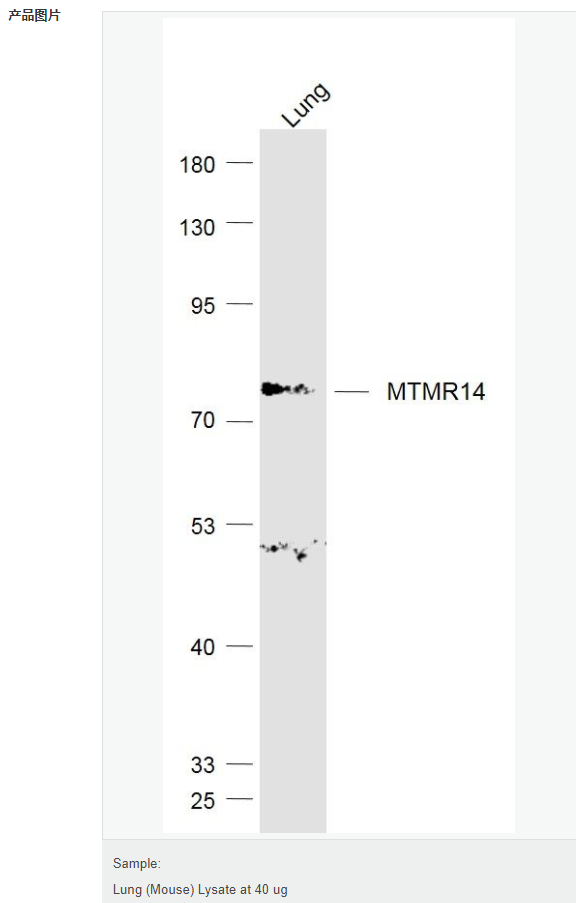
货号
产品规格
售价
备注
BN40290R-100ul
100ul
¥2360.00
交叉反应:Mouse(predicted:Human,Rat,Chicken,Dog,Pig,Cow,Horse,Rabbit,Sheep) 推荐应用:WB,IHC-P,IHC-F,ICC,IF,ELISA
BN40290R-200ul
200ul
¥3490.00
交叉反应:Mouse(predicted:Human,Rat,Chicken,Dog,Pig,Cow,Horse,Rabbit,Sheep) 推荐应用:WB,IHC-P,IHC-F,ICC,IF,ELISA
| 英文名称 | MTMR14 |
| 中文名称 | 肌管素相关蛋白14抗体 |
| 别 名 | C3orf29; Egg derived tyrosine phosphatase homolog; FLJ11546; FLJ22405; FLJ46453; FLJ90311; HCV NS5A transactivated protein 4 splice variant A binding protein 1; HCV NS5A-transactivated protein 4 splice variant A-binding protein 1; hJumpy; jumpy; MTMR 14; MTMR14; MTMR-14; MTMRE_HUMAN; Myotubularin related protein 14; Myotubularin-related protein 14; NS5ATP4ABP1. |
| 研究领域 | 细胞生物 免疫学 激酶和磷酸酶 |
| 抗体来源 | Rabbit |
| 克隆类型 | Polyclonal |
| 交叉反应 | Mouse, (predicted: Human, Rat, Chicken, Dog, Pig, Cow, Horse, Rabbit, Sheep, ) |
| 产品应用 | WB=1:500-2000 ELISA=1:5000-10000 IHC-P=1:100-500 IHC-F=1:100-500 ICC=1:100-500 IF=1:100-500 (石蜡切片需做抗原修复) not yet tested in other applications. optimal dilutions/concentrations should be determined by the end user. |
| 分 子 量 | 72kDa |
| 细胞定位 | 细胞浆 细胞膜 |
| 性 状 | Liquid |
| 浓 度 | 1mg/ml |
| 免 疫 原 | KLH conjugated synthetic peptide derived from human MTMR14:161-260/650 |
| 亚 型 | IgG |
| 纯化方法 | affinity purified by Protein A |
| 储 存 液 | 0.01M TBS(pH7.4) with 1% BSA, 0.03% Proclin300 and 50% Glycerol. |
| 保存条件 | Shipped at 4℃. Store at -20 °C for one year. Avoid repeated freeze/thaw cycles. |
| PubMed | PubMed |
| 产品介绍 | Myotubularin-related protein 14 (MTMR14), also known as Jumpy, is a myotubularin-related phosphoinositol-3-phosphate (PI3P) phosphatase (1). Mutations in the MTMR14 gene have been associated with centronuclear myopathy (1). MTMR14 deficiency in mice leads to altered calcium homeostasis and muscle disorders (2). MTMR14 has also been shown to play a role in autophagy, a process that is highly regulated by phosphatidylinositides through the type III PI3K, Vps34 (3). MTMR14 was localized to autophagic isolation membranes and early autophagosomes (3). In these studies, MTMR14 inhibited autophagy and mutations of MTMR14 associated with centronuclear myopathy were also defective in autophagy inhibition. In zebrafish, MTMR14 knockdown was shown to increase the number of autophagosomes, suggesting that its activity is associated with an inhibition of autophagy (4). Function: Lipid phosphatase which efficiently dephosphorylates phosphatidylinositol 3-phosphate (PtdIns3P) and PtdIns(3,5)P2; inactive toward PtdIns4P, PtdIns(3,4)P2, PtdIns(4,5)P2 and PtdIns(3,4,5)P3. Subunit: Belongs to the protein-tyrosine phosphatase family. Non-receptor class myotubularin subfamily. Subcellular Location: Cytoplasm. Found in reticular structures and plasma membrane ruffles. Concentrated near the nucleus. Tissue Specificity: Expressed in various tissues, including heart, skeletal muscle, placenta, liver, lung, kidney and pancreas. DISEASE: Defects in MTMR14 may be a cause of centronuclear myopathy autosomal dominant (ADCNM) [MIM:160150]; also known as autosomal dominant myotubular myopathy. Centronuclear myopathies are congenital muscle disorders characterized by progressive muscular weakness and wasting involving mainly limb girdle, trunk, and neck muscles. It may also affect distal muscles. Weakness may be present during childhood or adolescence or may not become evident until the third decade of life. Ptosis is a frequent clinical feature. The most prominent histopathologic features include high frequency of centrally located nuclei in muscle fibers not secondary to regeneration, radial arrangement of sarcoplasmic strands around the central nuclei, and predominance and hypotrophy of type 1 fibers. Similarity: Belongs to the protein-tyrosine phosphatase family. Non-receptor class myotubularin subfamily. SWISS: Q8NCE2 Gene ID: 64419 Database links: Entrez Gene: 64419 Human Entrez Gene: 97287 Mouse Omim: 611089 Human SwissProt: Q8NCE2 Human SwissProt: Q8VEL2 Mouse Unigene: 475382 Human Unigene: 197816 Mouse Important Note: This product as supplied is intended for research use only, not for use in human, therapeutic or diagnostic applications. |
